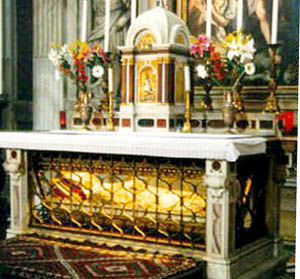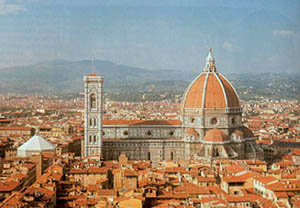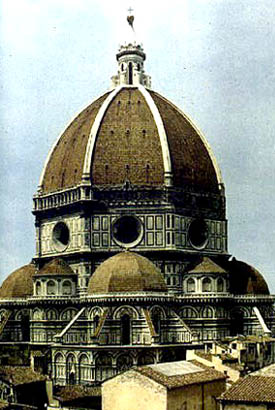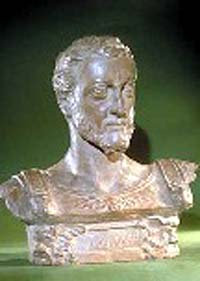 |
The Saint of the Day
St. Antoninus, May 10
Prof. Plinio Corrêa de Oliveira
Biographical selection:
Antonio was born at Florence in 1389 to noble parents of high standing. The name Antoninus, Little Anthony, was the affectionate nickname given him by his fellow citizens because of his short stature.

The body of St. Antoninus is preserved under an altar in the Dominican Church of San Marco
|
From early childhood, he applied himself to learning and study, and was known for his keen intelligence and piety. Influenced by the sermons of Blessed John Dominic, a great Italian religious reformer of the period, Antoninus applied for admission to the Dominican Order at age 15, and was accepted a year later. With Fra Angelico and Fra Bartolommeo, the one to become famous as a painter, the other as a miniaturist, he was sent to Cortona to make his novitiate under Blessed Lawrence of Ripafratta.
Later he was elected the Dominican Superior of Tuscany and Naples, where he zealously applied the reforms of his mentor. In 1445, when Pope Eugene IV was seeking an Archbishop for Florence, Fra Angelico, who was a friend of the Pope, suggested St. Antoninus. The Pope named him Archbishop of Florence and he entered the city in great pomp, as was the custom.
He strove energetically to wipe out public scandals and remedy the many abuses in his Diocese. Prince Cosimo de Medici used to say that everything good that the city had was due to the prayers of its holy Archbishop. He was called by Eugene IV to assist him in his dying hours. He was also frequently consulted by Pope Nicholas V on questions of Church and State.
Comments of Prof. Plinio:
Florence at that time was in a tournant de l’Histoire [turning point of History], that is, a time in which it was taking a new course, changing directions. This was because, even though the influence of the Renaissance had been strong in Florence, some of the inhabitants of the city had begun to reject its spirit, and were looking again to the medieval past of Italy. Florence, home to great artists who realized works of extraordinary beauty in the city, had been a focal point for spreading the Renaissance.

The city is dominated by the dome of the Cathedral, detail below, constructed in the high Middle Ages and Renaissance
 |
Florence was not a secondary city, as it is today, but was the center of the Grand Dukes of Tuscany, whose dynasty – the Medicis – were linked to the best houses of Europe, among them the house of France. Both Mary and Catherine of Medici would be Queens of France. The city also exerted a strong influence in the Church and more than one Pope came from that family. The Medicis were, in fact, one of the most powerful and important families of Europe.
So it was that Divine Providence sent a saint to this city. A saint whom Fra Angelico (Blessed Giovanni de Fiezoli) recommended to be its Prelate. The innocent and supposedly naïve Fra Angelico was the one who had the sagacity and perspicacity to point out St. Antoninus as a good candidate for the Archbishopric of Florence. So, there was at that time the reformer Blessed John Dominic, the teacher of our saint, Blessed Lawrence of Ripafratta, who was his novitiate master, Blessed Fra Angelico, a saint himself, and St. Antoninus, all living at the same time in and around Florence.
One sees that Florence was the very hub of the revolutionary spirit of the Renaissance, but at the same time also a place where God sent His saints to make a counter-attack against that same Renaissance. In this scenario, we find St. Antoninus, who assumed the office of Archbishop of Florence with great pomp and circumstance.
The selection does not mention how St. Antoninus carried out an enormous action to combat the Renaissance and to establish austerity in the customs of his Diocese. Good historians often acknowledge that the action of St. Antoninus caused the Renaissance movement to lose some of its vigor and momentum in Florence and, as a consequence, in Italy.
The importance of his actions was indirectly recognized by the eminent and condemnable Cosimo de Medici, when he recognized the great value of the prayers and work of St. Antoninus. Therefore, St. Antoninus did much good for the glory of God and strove to do what he could to stop the Renaissance.
Someone could object: I don’t understand the sense of this work of Providence. The life of St. Antoninus was like a meteor that passes and shines brightly for a moment. It was able to briefly arrest the course of events, but did not manage to stop the catastrophe. Therefore, it was a failure for the glory of God.
The answer is not difficult. First, to contain the march of the Renaissance in Florence was in itself a great work for the glory of God. St. Ignatius of Loyola used to say that if he spent his entire life to prevent just one more mortal sin of a person condemned to Hell, he would be satisfied, because of the enormous glory given to God this would represent. If you apply the same principle to the life of St. Antoninus, you can realize the great glory God received from his action, which in some way broke the impetus of the wave of the Renaissance.

Duke Cosimo de Medici
|
Second, the life of St. Antoninus confirms the existence of a deep root of good in Florence which opposed the Renaissance, as do the lives of Fra Angelico and Blessed John Dominic and the other saints living in the city at that time. This indicates that the plan of Divine Providence was to stop the Renaissance to restore something that continued the spirit of the Middle Ages, for which Florence would act as the hub. Fra Angelico is an expression of this possible future.
But what most probably happened is that other souls chosen for this mission did not correspond to their vocation. If they had done so, Florence would have converted, the Renaissance could have died in Italy, and World History could have been different. Working from the same hypothesis, we can say that if Florence did not convert, and the errors of the Renaissance continued to spread from Italy throughout Europe generating Protestantism, the French Revolution and Communism, this process, in final analysis, could be the result of those persons living at that time who did not listen to the call of God.
This is my response to the objection. What is more, you can clearly see the great responsibility of the souls called by God for some work. Their response can be decisive in the plan of Divine Providence, and a whole historic process can rely on their correspondence to grace.
We should ask St. Antoninus, who Divine Providence positioned in a time and place that was the key point for many future historic developments, to help us to follow his example and be entirely faithful to the plan that Our Lady has put before us.


  | | Prof. Plinio Corrêa de Oliveira | |
The Saint of the Day features highlights from the lives of saints based on comments made by the late Prof. Plinio Corrêa de Oliveira. Following the example of St. John Bosco who used to make similar talks for the boys of his College, each evening it was Prof. Plinio’s custom to make a short commentary on the lives of the next day’s saint in a meeting for youth in order to encourage them in the practice of virtue and love for the Catholic Church. TIA thought that its readers could profit from these valuable commentaries.
The texts of both the biographical data and the comments come from personal notes taken by Atila S. Guimarães from 1964 to 1995. Given the fact that the source is a personal notebook, it is possible that at times the biographic notes transcribed here will not rigorously follow the original text read by Prof. Plinio. The commentaries have also been adapted and translated for TIA’s site.
|
Saint of the Day | Home | Books | CDs | Search | Contact Us | Donate

© 2002- Tradition in Action, Inc. All Rights Reserved
|
 |

|